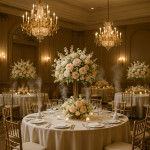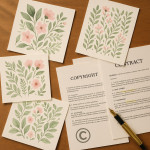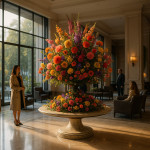Shipping large floral sculptures abroad: packaging specs and carrier matrix
Exporting oversized flower arrangements or botanical sculptures is no small feat. This guide walks you through proven packaging specifications, a side-by-side carrier matrix, and critical paperwork tips so your living or preserved artwork lands intact—and on time—anywhere in the world.
Why shipping large floral sculptures is uniquely challenging
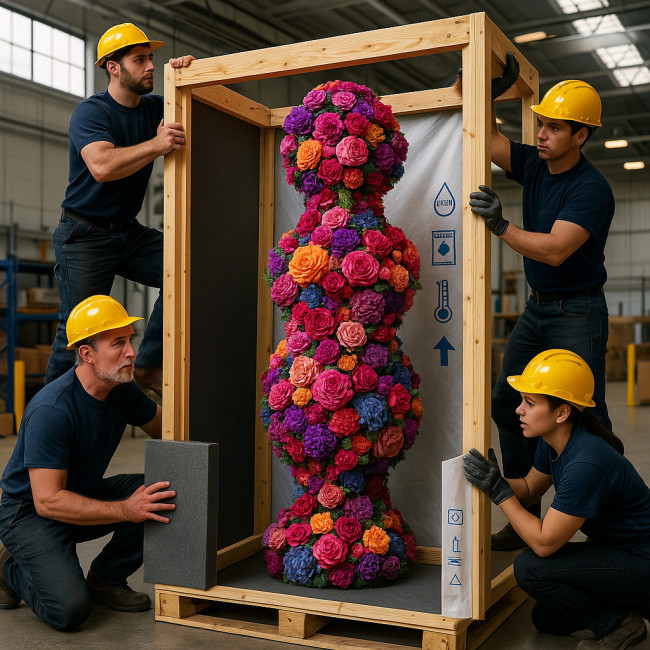
Unlike traditional art pieces, floral sculptures combine bulk, fragility and, in many cases, biological material. Breaks, bruising, mould and customs delays can all derail a project and erode client trust. Mastering crate design, temperature buffers and carrier selection significantly reduces those risks.
Step-by-step packaging specs that survive long hauls
1. Crate construction
- Plywood walls ≥ 12 mm with internal cross-bracing to prevent bowing.
- IPPC heat-treated timber to pass phytosanitary controls.
- Recessed steel butterfly latches for quick inspections without splintering the frame.
2. Cushioning layers
For flower heads and delicate stems, foam density matters. Opt for 45 kg/m³ closed-cell PE foam; it absorbs vibration yet resists moisture. Combine with breathable Tyvek® sleeves to reduce condensation.
3. Moisture & climate control
- Line the crate with a 250-micron polyethylene barrier bag.
- Add 200 g desiccant packs per m³ of internal volume.
- For preserved blooms, insert phase-change gel packs set at 18 °C to avoid petal cracking below 10 °C.
4. Internal rigging
- Velcro-strapped armatures around major stems keep weight off petals.
- Use polyprop webbing not cotton: it won't wick moisture.
5. Shock & tilt indicators
Attach both on two adjacent crate faces. Most insurers demand photographic evidence of unused indicators before dispatch and after delivery.
Carrier matrix: compare services at a glance
| Carrier / Service | Max Size (L×W×H) | Max Weight | Climate Control | Insurance Limit (USD) | Avg. Transit Days | Best For |
|---|---|---|---|---|---|---|
| FedEx International Priority Freight | 302 × 203 × 178 cm | 1 000 kg | Passive only | 50 000 | 3-5 | Time-sensitive installs |
| DHL Air Thermo Control | 300 × 200 × 160 cm | 950 kg | 2-8 °C or 15-25 °C | 100 000 | 4-6 | Live plants & humid exotics |
| UPS Worldwide Expedited | 270 × 200 × 160 cm | 700 kg | Passive only | 50 000 | 5-8 | Budget-driven projects |
| DB Schenker Art Premium | 350 × 220 × 200 cm | 1 200 kg | Custom ranges | 250 000 | 6-9 | Museum-grade one-offs |
| Regional Fine-Art Courier (white-glove) | Variable | Variable | Custom ranges | On request | Depends on route | Door-to-door installs incl. mounting |
Need tailored risk coverage? Dive into our step-by-step sculpture shipping insurance guide before you finalise the AWB.
Documentation that customs officers love
Commercial invoice essentials
- Botanical species list (Latin names) for CITES clearance.
- HS code 0603.90 for prepared cut flowers or 9703.00 for original artworks—pick the one that reflects your material base.
Phytosanitary and fumigation certificates
If your piece includes untreated natural stems, secure certificates from the agriculture authority before crating; many ports require originals in the pouch.
ATA Carnet vs. permanent export
For touring exhibitions, an ATA Carnet speeds up border crossings and avoids duties. Permanent sales need a standard export declaration plus the buyer's import permit.
Pre-flight checklist
- Book carrier ≥ 14 days ahead to reserve oversized cargo hold positions.
- Send crate dimensions to the airline's loadmaster for pallet mapping.
- Arrange final bloom misting within two hours of pickup.
- Photograph every layer of packing—insurers increasingly demand a visual log.
Common pitfalls & how to avoid them
- Over-tight packing: petals bruise. Always allow 2 cm clearance around heads.
- Ignoring humidity shifts: preserved moss can mould above 65 % RH.
- Generic declared value: itemised valuations speed up claim approvals.
For deeper specs on foam densities and layering, consult our guide to advanced fragile-art packaging specs; principles translate perfectly to floral media.
Real-world mini-case study
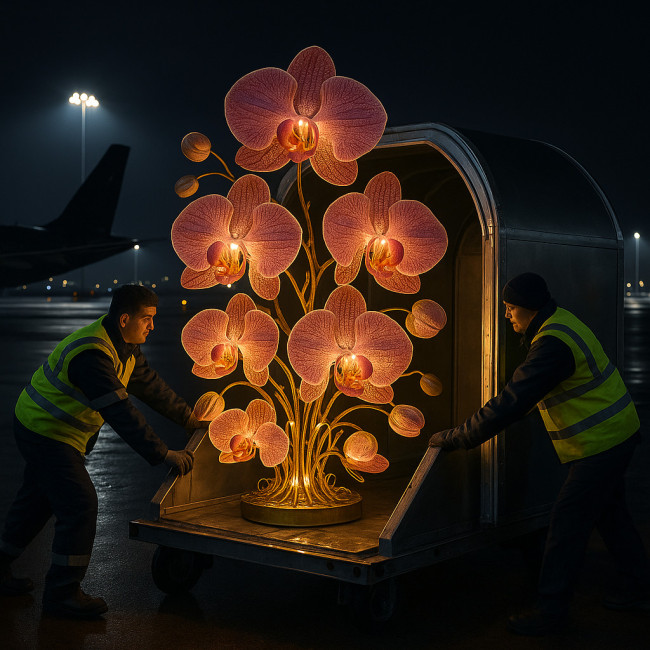
A Singapore hotel commissioned a 2 m-tall hanging orchid chandelier. Using climate-controlled DHL Air Thermo Control, we maintained 18 °C from Paris to Changi. A data-logger revealed only a 1.5 °C variance, and desiccant levels stayed under 45 % RH. Transit time: 68 hours, zero petal loss. The hotel has since reordered two sculptures—proof that meticulous specs pay off.
Interactive quiz: test your shipping savvy
FAQ
- Can I ship live plants and preserved blooms in the same crate?
- It's discouraged. Live plants need higher humidity, which can damage preserved elements. Use separate crates or hermetic inner chambers.
- What insurance value should I declare?
- Declare the full replacement cost, including material, artist fee and re-installation labour. Under-valuation may void claims.
- How early should I start paperwork for CITES-listed species?
- Begin at least four weeks before departure. Some authorities process permits only once a month.
Explore more logistics insights and browse vetted floral art logistics specialists ready to execute complex installs worldwide.
Next steps
Ready to draft your shipment brief? Download our risk-free sample shipping agreement template and align carriers, insurers and clients before production begins. For fragile mixed-media pieces, see fragile ceramics global shipping standards to cross-check moisture barriers.
CTA: Need hands-on support? Contact our studio logistics team for a custom crate design and carrier booking that fits your timeline and budget.

